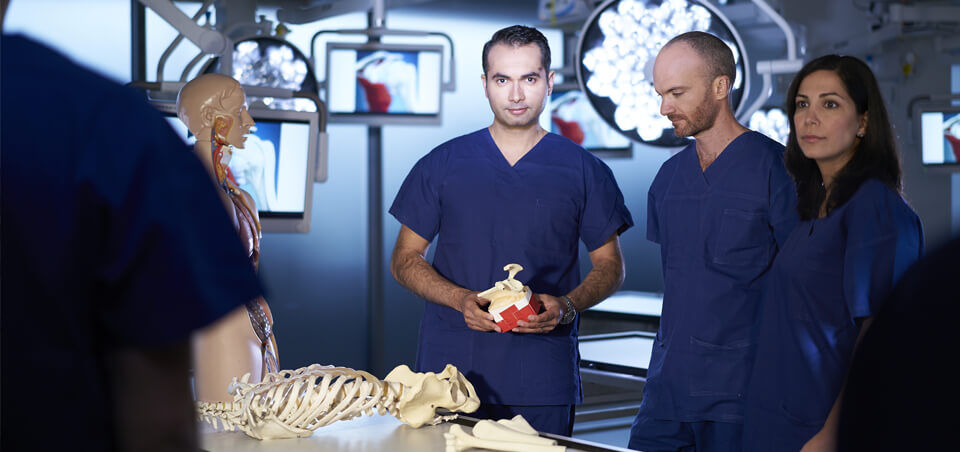Distal Biceps Tendon Rupture
Knowledge that empowers
What is it?
The biceps brachii (biceps) is a muscle on the front of the upper arm that assists in bending (flexing) the elbow and even more important in turning the palm upwards (supination), and it also plays a small role in movement at the shoulder.
It is particularly important for lifting heavy objects and activities that involve twisting the forearm such as turning a screwdriver or opening a jar. As you follow the muscle belly down towards the elbow, it forms a tendon known as the distal biceps tendon. This tendon crosses the front of the elbow and attaches to a bony prominence known as the radial tuberosity.
A distal biceps tendon rupture refers to an injury where the distal biceps tendon is torn. It can occur in the middle of the tendon, however it is more likely to be torn away from its insertion to the radius bone. It usually occurs by excessive eccentric tension as the arm is forced from a flexed to an extended position “flexed elbow unacceptably challenged”. It is common to hear patients describe the heavy object slipping or moving awkwardly before they try to catch or stabilise it.

Who is affected?
Interestingly, distal biceps tendon ruptures are far more common in men than women, and this is likely due to men being more likely to take part in tasks that involve heavy manual labour or lifting.
You are more likely to tear this tendon if you have had a previous injury to the biceps tendon, are a smoker, have taken extended courses of anabolic steroids or corticosteroid medications.
What are the symptoms?
When the distal biceps tendon is torn, there is often a popping or tearing sensation felt at the front of the elbow.
This may initially be quite painful, however this pain normally subsides over the course of a few days or perhaps even a week or so. The elbow and arm may become very swollen and bruised.
As the pain and swelling subsides, the most noticeable symptom of a distal biceps tendon rupture is a feeling of weakness, particularly in those movements that the biceps is responsible for, being flexion of the elbow and supination.
How is the diagnosis made?
Distal biceps tendon rupture is mainly a clinical diagnosis.
On physical examination of the elbow, a positive “hook” test is an extremely accurate and reliable test for detecting this injury. If the tendon has completely torn, a change in the contour of the muscle (“Reverse Popeye” sign) is seen in the arm.
Diagnostic imaging of the elbow isn’t completely necessary to confirm this injury; however, it is particularly important to help plan for surgical repair of the tendon, to define the position and grade of the tear, as well as to assess where the distal tendon stump is located. To this end, an MRI is the most reliable imaging technique.
What is the prognosis?
Following distal biceps tendon rupture, healing of the tendon to the bone is not possible without surgery because the tendon retracts and no longer has contact to its normal bony insertion.
If the injury is overlooked or not treated, the patient will lose 50% sustained supination strength, 40% supination strength, 30% flexion strength and 15% grip strength
It is therefore very important to consult with your general practitioner so that they can refer you for an opinion from a Shoulder and Elbow Surgeon.
Non surgical treatment
Immediately after the injury, it is important to manage pain and swelling with rest or immobilisation in a sling, wearing a light compressive garment and intermittently applying an ice pack to the elbow (i.e. apply ice for 20-30mins before taking it off for 20-30mins).
Non-steroidal anti-inflammatory medications may also be helpful however we recommend that these should only be taken under instruction from your doctor or pharmacist.
Should surgery not be possible, or should someone opt for non-surgical management, the injured person may experience weakness of the arm, cramping or spasms of the biceps muscle. The cosmetic appearance of the “Reverse Popeye” sign may also be bothersome. A physiotherapist can help guide a return to physical activity and prescribe strengthening exercises for the uninjured muscles of the forearm and elbow that assist in flexion and supination of the forearm.
Although it is not all that common, it is possible to partially tear the distal biceps tendon. In cases of a partial tear, a physiotherapist can help by developing an individualised rehabilitation program to reduce pain and swelling, and assist in guiding a graded return to work or manual labour.
Surgical treatment
It is generally accepted that surgical repair of a ruptured distal biceps tendon is the optimal management to restore the normal function of the biceps muscle.
This is because the other muscles that assist in flexing and supinating the forearm can not compensate for the loss of the biceps brachii muscle’s function once it is ruptured.
Surgical repair of a distal biceps tendon involves reattachment of the tendon to its bony insertion. This procedure is classically done through a single incision with deep dissection in the front of the forearm.
However, the double-incision technique (front and back) is less invasive to important structures present in the forearm and allows for a more anatomic reconstruction of the tendon.
The outcomes of surgical repair for distal biceps tendon rupture are, in most cases, excellent. That being said, strict adherence to the post-surgical rehabilitation program is vital to reduce the risk of re-rupture. This process can take approximately 6 months and usually involves:
- Protecting the repair in a brace for the first 6 weeks after surgery
- Range of motion exercises to restore normal motion to the elbow
- Commencement of a strengthening program at 3 months after surgery
